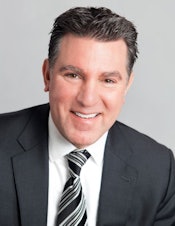
DrBicuspid.com is pleased to present the next column from two lawyers who spend every day defending dentists in litigation and before the licensing board. The purpose of this column is to offer our readers a fresh perspective on common practice and risk management issues from attorneys who litigate these issues in the real world.
The eventual plaintiff, a 63-year-old, controlled hypertensive man who worked as a banker, presented to our client. The patient was found to have the following:
- Many fillings
- Several teeth that had been treated endodontically and restored
- Two three-unit bridges where one tooth on each arch had been extracted decades earlier
The patient had no significant complaints other than reporting more than occasional headaches, periodic "tight jaw muscles," and what his wife said was grinding while he slept.

Our client was an experienced general dentist who had been practicing some 20 years. She had no formal postdoctoral training or residency program, but had taken a series of hands-on and didactic courses given by a facility nationally known to provide advanced study in complex reconstructive dentistry.
Our client did a thorough clinical examination of the teeth, including occlusal assessments, and took periapical, bitewing, and panoramic radiographs. Radiographically, our client found what she characterized as flat condylar heads bilaterally. Clinically, the occlusion showed flattening of the cusps, no solid "home base" to rest, prominent masseters, a slight cant of the occlusal plane, and pinpoint tenderness when the left preauricular region was palpated.
She suggested to the patient that a computerized testing system be applied that would measure the patient's muscular activity in both relaxed and functional states; the patient agreed. The testing led the dentist to the conclusion that the neuromuscular activity of the masticatory apparatus was improper and that was caused by the misalignment of the occlusion, which was the cause of the headaches, muscle tightness, and night grinding.
Our client suggested a treatment plan, costing $120,000, which involved making roundhouse bridges for both arches, starting with the mandible. Remarkably, the patient needed little convincing and finances were not an issue, so the treatment began shortly thereafter.
The dentist prepared all of the lower teeth and made a lab-processed provisional, which was temporarily cemented. The patient reported immediate discomfort, but the dentist said that it will take some getting used to. However, over the course of a dozen visits during the next month, adjustments to the provisional were made, and adjustments were also made to the natural maxillary teeth.
Unfortunately, the patient's discomfort could not be relieved, so the dentist suggested preparing the upper teeth and placing a provisional on them, which she accomplished. This provided no relief.
So the dentist made the final bridge for the lower arch, thinking that she needed to work toward the final product as quickly as possible to make her patient comfortable, but the occlusal and muscular discomfort was not relieved. In fact, the patient also complained that the new lower bridge was annoyingly bulky. Our client did some adjustments on the lower to remove some bulk and then suggested to the patient that he will be better off if he allows her to complete the case and make the final bridge for the upper.
By this time, the patient was very unhappy, asked for and received a complete copy of his records, and went to a prosthodontist, who was grossly critical of the dentist for undertaking such a large reconstruction for what he stated to be "for no reason at all" and for "destroying the occlusal plane."
The prosthodontist said that the only way for him to treat the patient was to take everything off and start from scratch, with now no choice but to follow our client's overall plan. The cost would be $150,000, and would take the better part of six months. The patient went along with the prosthodontist. By the time both arches had permanent bridges affixed temporarily, his symptoms had abated significantly but not completely. Throughout the lawsuit that followed, the patient claimed that he never got fully back to his pretreatment state of relative comfort.
Legal stance
The patient filed suit, claiming that the dentist was negligent in performing treatment that was unnecessary in the first place and doing so in a negligent manner so as to create an unacceptable occlusion. One of the allegations was that the dentist was educationally unqualified to perform the treatment that she did. Damages claims included the costs of the now-defendant dentist because that treatment was claimed to be unnecessary, the costs of the prosthodontist's treatment, the severe pain and suffering from the time the defendant started her work until the prosthodontist was able to stabilize the bite, and ongoing pain and suffering, which the prosthodontist said will never fully abate.
At deposition, the plaintiff was very credible and seemed angry with himself for falling prey to a "salesmanship pitch"; we assessed him as having good jury appeal. Our client made a professional, yet very assertive, appearance at her deposition; she fervently defended the treatment she had provided, referring back to the coursework she had taken as being the gold standard and arguing that, if the patient had only permitted her the opportunity to finish the treatment plan, he would have been in ideal occlusion and symptom-free. This latter approach would give us the strongest defense basis.
Issues raised
- Pairing symptoms with potential treatment: In this case, there were radiographic signs of a condylar abnormality, but the flattening of the head could have been a result of age-related osteoarthritis as much as occlusion-related parafunctional habits. Clinically, the wearing away of occlusal anatomy in the middle-aged plaintiff could have arisen from years of certain dietary or personal habits as much as from structure-based problems. Headaches, muscle tightness, and bruxism may arise from a slew of conditions, including but not limited to occlusion. So, before dental treatment is instituted, the dentist must be sure that the symptoms to be treated actually need treatment and that they arose from a dental source.
- Extent of treatment: It was clear from the plaintiff's deposition testimony, as well as from discussions with the plaintiff's attorney, that the major trial position to be taken would be of taking on the absolute most extensive treatment plan, as compared with doing more conservative approaches from the start. The plaintiff's attorney asked our client at deposition whether she considered making some type of mouthguard to see if that would provide any help or whether she considered placing the patient on anti-inflammatory medication or stress-lowering drugs. She simply said, "No, these problems were caused by the bite, and the bite needed to be fixed, regardless of how much work was involved with that fixing." While informed consent was not raised in this case, the concept of less aggressive alternative therapies was dismissed by the dentist, who had a vision for this case that was not to be derailed.
Case resolution: Settlement reached before trial
We saw a number of stumbling blocks with taking this case to trial, as discussed above, but possibly the greatest was our client's view of the clinical aspect of the case with a "blinders-on" approach, which could be seen by the jury in an unfavorable light, especially when placed against the serious, credible plaintiff who was remorseful for having gone along with something he regretted.
When the patient initially presented to our client, he reported, both orally and on initial paperwork, that he had headaches, jaw muscle tightness, and night grinding, so one of our approaches to try to reduce the case value was to point out, at every opportunity we had during discussions with plaintiff's counsel, that the symptoms the plaintiff left with were essentially the same as those with which he presented, and it was only a matter of subjective degree that could not be quantified.
We also took the position that our client should not be penalized, because the plaintiff did not give her the chance to complete her work, and nobody can ever know, one way or the other, whether our client's completed work would have ended all the problems, as she fervently contended.
Our client understood how both she and the plaintiff would be perceived, and how a jury could realistically award an amount of money well higher than the amount for which we could settle, which was essentially a dollar-for-dollar amount paid by the plaintiff for his dental treatment, without any additional for pain and suffering. So, we settled the case.
Practice tips
- Practicing within the dentist's ability: This issue addresses the plaintiff's claim that the defendant dentist did not have the educational qualifications to undertake this complex treatment plan. Legally speaking, a general dentist is permitted to perform all aspects of dentistry that are allowed as dental treatment within the practice rules of the dentist's jurisdiction of practice. In other words, a general dentist may perform what a specialist may perform. However, good practice concepts and good risk management dictate that dentists are most prudent in staying within areas of practice in which they have experience and training. And even when a dentist has specific training, as our client here did, dentists will reduce risk when they self-examine to determine whether they are truly qualified to do what they propose: Perhaps, a good test is whether the dentist would do the same treatment on a loved one.
- The salesmanship of dentistry: We are in an era in which competition in dentistry, especially for dentists in solo or small practices who see large corporate practices growing and eating into patient numbers, is great. So, when a big case comes into the office, the temptation is to "sell" it to the patient. This is not a new phenomenon, because sales has always been an aspect of the business of dentistry, but many view it as more prevalent now than ever before. We see a good rule to be that the dentist is internally certain that what is proposed to the patient is truly proper for the patient and, again, within the dentist's ability level.
- Test results can be deceiving: Autopsy results of 20-year-old Marines who died in Vietnam revealed that a more significant percentage of them than would have been intuitively anticipated had measurable coronary artery disease. Had a pre-enlistment angiography been performed on all of them, the test results would have shown the plaques, but that would not have indicated the need for all of them to have had coronary bypass grafts. Similarly, simply because radiographs show abnormal looking condyles or neuromuscular electrical studies show inappropriate firing of masseters does not necessarily constitute a dental indication to rework the entire maxillomandibular dentition. Test results are best when used as only a part of the picture and in conjunction with clinical findings and patient reports as to function. Dentists treat patients, and not test results.
William S. Spiegel, Esq., is a partner at the law firm Spiegel Leffler in New York City. He is a former assistant corporation counsel to the City of New York -- Medical Malpractice Division.
Marc R. Leffler, DDS, Esq., is also a partner at Spiegel Leffler. He received his dental degree from Columbia University, completed a residency in oral and maxillofacial surgery at New York University, and is a diplomate of the American Board of Oral and Maxillofacial Surgery.
Disclaimer: Nothing contained in this column is intended as legal advice. Our practice is focused in the state of New York, and there are variations in rules of practice, evidence, and procedure among the states. This column scratches the surface on many legal issues that could call for a chapter unto themselves. Some of the facts and other case information have been changed to protect the privacy of actual parties.
The comments and observations expressed herein do not necessarily reflect the opinions of DrBicuspid.com, nor should they be construed as an endorsement or admonishment of any particular idea, vendor, or organization.



















